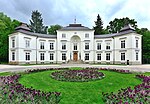Bust of Piotr Wysocki

The bust of Piotr Wysocki, also known as the Piotr Wysocki Monument, is a monument in Warsaw, Poland, located in the Royal Baths Park, within the Downtown district. The sculpture consists of a bronze bust depicting Piotr Wysocki, a 19th-century military officer, a colonel in the Army of Congress Poland, and one of the organisers and commanders of the November Uprising. It was made in 1926 by Aleksander Żurakowski, and unvailed in 1930 in town of Ostrów Mazowiecka where it remained until the outbreak of the Second World War during which it disappeared. It was rediscovered in 1978, and placed in the Na Książęcem Park. It was relocated to its current location in 1980.
Excerpt from the Wikipedia article Bust of Piotr Wysocki (License: CC BY-SA 3.0, Authors, Images).Bust of Piotr Wysocki
Szwoleżerów, Warsaw Midtown
Geographical coordinates (GPS) Address Nearby Places Show on map
Geographical coordinates (GPS)
| Latitude | Longitude |
|---|---|
| N 52.215413055556 ° | E 21.037503888889 ° |
Address
Podchorążówka
Szwoleżerów
00-465 Warsaw, Midtown
Masovian Voivodeship, Poland
Open on Google Maps











